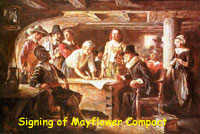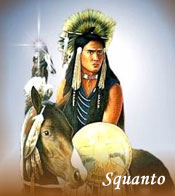|
The celebration of Thanksgiving in America was probably derived from the harvest-home ceremonies originally held in England. These were days reserved to thank God for plentiful crops and a bountiful harvest. Accordingly, this holiday still takes place late in the Fall Season, after crops have been gathered. Most recently, Thanksgiving Day in the United States is usually a family affair, complete with sumptuous dinners and happy reunions; however, it is also traditionally a time for serious religious contemplation, church services and prayer. The first observance of Thanksgiving in America was entirely religious in nature and involved no form of feasting. On December 4, 1619, a group of 38 English settlers arrived at Berkeley Plantation on the James River...a location now known as Charles City, Virginia. The charter of the group required that the day of arrival be observed as a Day of Thanksgiving to God. The first
Thanksgiving in the New England area was celebrated in 1621, a
little less than a year after the Plymouth colonists had settled
in America. Popularly known as the Pilgrims, they had set sail
from Plymouth, England on a ship called the Mayflower on
September 6, 1620. They were fortune hunters, bound for the
resourceful 'New World'. The Mayflower was a small ship crowded
with men, women and children, besides the sailors on board.
Aboard were passengers comprising the 'separatists', who called
themselves the "Saints", and others, whom the Contrary to popular belief, however, Plymouth Rock was not the site of the original colony. When the Pilgrims landed there on December 11, 1620 in search of fresh provisions, they were greeted with hostility by the natives in the immediate vicinity and put back out to sea almost at once. A little further south, they came across Cape Cod, a much more favorable anchorage than Plymouth had proved to be and a native population which was more cordial in nature. Weary from their voyage and in no mood to hunt down the site mandated by their charter (which was considerably further down the coast and somewhere within the limits of the original grant of the Virginia Company of Plymouth), the Pilgrims decided to establish their colony within this friendly territory.
The festival lasted three days. Massasoit, local sachem or chief of the Wampanoag, together with 90 Indians from the various Eastern Woodlands Tribes, participated in the ceremony. There can be little doubt that the majority of the feast was most likely furnished by the indigenous population. It is certain that they provided venison. The remainder of the meal, eaten outdoors around large tables, also probably included fish, berries, boiled pumpkin, watercress, leeks, lobster, dried fruit, clams, wild plums and cornbread. The celebration of this first New England Thanksgiving is believed to have taken place sometime between September 21 and November 9. The event, however, was a one-time celebration. It was not repeated the following year, nor was it intended to be an annual festival. It was not until 55 years later than another Thanksgiving Day was officially proclaimed, when the Governing Council of Charlestown, Massachusetts convened on June 20, 1676 to weigh how to best express thanks for the good fortune that had secured the establishment of their community. By unanimous vote, Edward Rawson (the Clerk of the Council) was instructed to announce June 29 as a Day of Thanksgiving. Yet again, this proved to be only a one-time event. The story of Thanksgiving continues in "How it became a National Holiday?"
|
||||||||


 After land was
sighted in November following 66 days of a lethal voyage, a
meeting was held and an agreement of truce was worked out
between the Saints and Strangers. It was called the Mayflower
Compact. The agreement guaranteed equality among the members of
the two groups. They merged together to be recognized as the
"Pilgrims." They elected John Carver as their first
governor.
After land was
sighted in November following 66 days of a lethal voyage, a
meeting was held and an agreement of truce was worked out
between the Saints and Strangers. It was called the Mayflower
Compact. The agreement guaranteed equality among the members of
the two groups. They merged together to be recognized as the
"Pilgrims." They elected John Carver as their first
governor.
 That initial
harsh Massachusetts winter killed approximately one-half of the
original 102 colonists. In the following Spring of 1621, the
Indians, led by two braves named Samoset (of the Wampanoag
Tribe) and Squanto (of the Patuxtet Tribe), taught the survivors
how to plant corn (called "maize" by the natives) and
how to catch alewives (a variety of the herring family) in order
that the fish might be used as a fertilizer to growing pumpkins,
beans and other crops. Samsoset and Squanto also instructed the
Pilgrims in the arts of hunting and angling. By that Summer,
despite poor crops of peas, wheat and barley, a good corn yield
was expected and the pumpkin crop was bountiful. In early
Autumn, to recognize the help afforded the colonists by the
Indians and to give thanks for having survivied, Governor
William Bradford arranged for a harvest festival. Four men were
sent "fowling" after ducks and geese. Turkey may or
may not have been a part of the forthcoming meal since the term
"turkey" was used by the Pilgrims to mean any type of
wild fowl.
That initial
harsh Massachusetts winter killed approximately one-half of the
original 102 colonists. In the following Spring of 1621, the
Indians, led by two braves named Samoset (of the Wampanoag
Tribe) and Squanto (of the Patuxtet Tribe), taught the survivors
how to plant corn (called "maize" by the natives) and
how to catch alewives (a variety of the herring family) in order
that the fish might be used as a fertilizer to growing pumpkins,
beans and other crops. Samsoset and Squanto also instructed the
Pilgrims in the arts of hunting and angling. By that Summer,
despite poor crops of peas, wheat and barley, a good corn yield
was expected and the pumpkin crop was bountiful. In early
Autumn, to recognize the help afforded the colonists by the
Indians and to give thanks for having survivied, Governor
William Bradford arranged for a harvest festival. Four men were
sent "fowling" after ducks and geese. Turkey may or
may not have been a part of the forthcoming meal since the term
"turkey" was used by the Pilgrims to mean any type of
wild fowl.